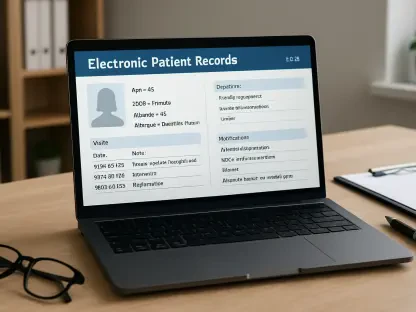As the critical deadline of September 30 approaches, the fate of Medicare telehealth flexibilities and Hospital-at-Home waivers hangs in the balance, casting uncertainty over millions of Americans who rely on virtual care for essential medical services. These provisions, which have transformed access to healthcare by enabling home-based consultations and expanding coverage beyond rural areas, are set to expire unless Congress can overcome significant political gridlock.
The Urgency of Congressional Action
Legislative Stalemate and Deadline Pressure
The urgent need for Congress to act before the September 30 deadline cannot be overstated, as Medicare telehealth flexibilities are on the verge of expiring. With only days remaining, the failure of continuing resolution (CR) proposals from both Republican and Democratic sides has deepened the crisis, leaving no clear path forward. The House remains in recess past the critical date, placing immense pressure on the Senate to find a solution. Meanwhile, the threat of a government shutdown looms large, further complicating negotiations. If no funding bill is passed, not only could virtual care provisions lapse, but broader federal operations might also halt, raising the stakes significantly. This deadlock stems from disagreements over funding timelines and unrelated policy issues, despite a shared recognition of telehealth’s value. The clock is ticking, and without an immediate resolution, both patients and healthcare providers risk losing access to vital services that have become a cornerstone of modern medical delivery.
Beyond the immediate deadline, the legislative stalemate reveals deeper systemic challenges in addressing healthcare policy under tight constraints. The Senate’s rejection of both parties’ CR proposals on September 19 has left negotiators scrambling to find common ground, but progress remains elusive. High-stakes discussions, including a meeting on September 29 with President Trump and key congressional leaders, have yielded little in terms of tangible outcomes. Political posturing over broader fiscal concerns threatens to overshadow the urgent need to protect telehealth access. Advocacy groups have intensified efforts to highlight the potential fallout, urging lawmakers to prioritize virtual care in any funding agreement. The complexity of balancing telehealth extensions with other legislative priorities illustrates the difficulty of achieving consensus in a polarized environment. As the deadline passes, the risk grows that temporary lapses could disrupt care continuity, leaving stakeholders anxiously awaiting a retroactive fix to mitigate the damage.
Navigating the Threat of Shutdown
The looming possibility of a government shutdown adds a critical layer of urgency to the telehealth debate, as federal funding hangs in the balance alongside virtual care provisions. If Congress fails to pass a funding bill by September 30, not only will telehealth flexibilities be at risk, but essential government services could also be interrupted, creating widespread repercussions. This dual threat has intensified negotiations, with lawmakers under pressure to avert a broader crisis while addressing the specific needs of Medicare beneficiaries. The potential shutdown has sparked debates over leveraging such an event for political gain, though recent reports suggest a shift toward compromise to avoid drastic measures like mass layoffs. For telehealth advocates, the shutdown risk underscores the fragility of current provisions and the need for a stable, long-term solution rather than temporary extensions. The intersection of fiscal policy and healthcare access has rarely been more evident, highlighting the stakes for millions.
Moreover, the shutdown threat has shifted focus to contingency planning among healthcare providers and advocacy organizations. Many are preparing for the worst-case scenario, where telehealth reimbursements could halt abruptly, forcing difficult decisions about service delivery. Groups like ATA Action are pushing for retroactive measures in any eventual funding bill to ensure providers are compensated for services rendered during a lapse. This situation exposes the vulnerability of virtual care programs to broader political and budgetary conflicts, raising questions about the sustainability of such innovations without permanent legislative backing. As tensions rise, the public’s reliance on telehealth—especially for home-based and audio-only services—remains a compelling argument for prioritizing these flexibilities. The coming days will test whether Congress can navigate these intertwined crises to protect a vital component of the healthcare system, or if partisan divides will prevail at the expense of patient care.
Bipartisan Support Amid Political Gridlock
A Rare Consensus on Telehealth Value
Amid the political turmoil, a rare bipartisan consensus has emerged on the importance of extending Medicare telehealth flexibilities and Hospital-at-Home waivers, reflecting a shared understanding of their transformative impact. Both Republican and Democratic CR proposals included provisions to preserve key features, such as allowing patients’ homes to serve as originating sites and suspending geographic restrictions that previously limited coverage to rural areas. Additional measures, like expanding eligible clinicians and supporting audio-only visits for non-behavioral health services, were also common ground, signaling a collective recognition of virtual care’s role in addressing healthcare disparities. This alignment suggests a broader policy shift toward integrating telehealth into mainstream medical practice, especially for Medicare beneficiaries who have come to rely on these services post-COVID. However, the unity on this issue struggles to translate into actionable outcomes as broader disputes loom large.
Despite this agreement, bipartisan support for telehealth is overshadowed by partisan disagreements on funding durations and unrelated health policy matters, stalling critical progress. The House Republicans’ CR aimed to extend flexibilities through November 21, while Senate Democrats proposed a shorter timeline ending October 31, reflecting differing priorities on fiscal scope. Although the core provisions mirrored each other, the Senate’s rejection of both plans has left negotiations in disarray. This deadlock highlights how even widely supported initiatives can falter when entangled with larger legislative battles, such as debates over Affordable Care Act subsidies and Medicaid policies. The frustration among stakeholders is palpable, as the value of virtual care is undisputed, yet political maneuvering threatens to undermine its continuation. As the deadline passes, the hope for a unified resolution rests on whether lawmakers can prioritize this consensus over divisive side issues.
Challenges in Translating Agreement to Action
Translating bipartisan support into concrete legislation remains a formidable challenge as political gridlock persists, casting doubt on the future of telehealth flexibilities. Despite shared goals, the lack of compromise on timelines and broader spending agreements has derailed efforts to secure an extension before the critical deadline. High-level talks involving key congressional leaders from both parties have failed to break the impasse, with each side holding firm on ancillary issues that overshadow the telehealth debate. The House’s absence during this pivotal period further complicates matters, leaving the Senate with the burden of pushing through a viable solution. This inertia not only jeopardizes virtual care access but also erodes public trust in the ability of lawmakers to address pressing healthcare needs. The urgency to resolve these differences cannot be understated, as every day of delay heightens the risk of service disruptions for vulnerable populations.
Furthermore, the broader context of healthcare policy disputes adds complexity to the telehealth negotiations, revealing the intricate web of interests at play. Democrats have signaled a willingness to negotiate a bipartisan spending deal, yet tensions over what they describe as a “Republican healthcare crisis” persist, muddying the waters. Meanwhile, Republican leaders push back against perceived overreaches in unrelated policy areas, further stalling consensus. For telehealth advocates, this environment underscores the need for targeted advocacy to keep virtual care at the forefront of discussions. The potential for a last-minute agreement remains, but it hinges on both sides setting aside larger ideological battles to focus on the immediate needs of Medicare patients. As the situation unfolds, the telehealth community watches closely, hoping that bipartisan goodwill can finally overcome the entrenched political barriers that threaten to undo years of progress in healthcare delivery.
Consequences of Inaction
Impact on Patients and Providers
Should telehealth flexibilities expire on September 30, the repercussions for Medicare patients and healthcare providers would be both immediate and profound, fundamentally altering access to care. A return to pre-COVID restrictions would limit telehealth coverage to rural areas and designated facilities, effectively excluding countless beneficiaries who rely on home-based services. Critical provisions, such as allowing homes as originating sites and supporting audio-only consultations for non-behavioral health needs, would vanish, disrupting care for those unable to travel to traditional settings. Innovative programs like Hospital-at-Home, which deliver acute care in home environments, could also cease without the necessary waivers. This rollback would disproportionately affect vulnerable populations, including the elderly and those with mobility challenges, stripping away a lifeline that has become integral to their medical care. The sudden shift would leave many scrambling for alternatives in an already strained healthcare system.
Providers, too, face significant challenges if these flexibilities lapse, with reimbursement uncertainties threatening their ability to sustain virtual care services. Without extensions, Medicare would no longer cover many telehealth visits, particularly those conducted from patients’ homes or by expanded categories of clinicians. Federally Qualified Health Centers (FQHCs) and Rural Health Clinics (RHCs) would lose their ability to bill as distant-site providers, further straining resources in underserved areas. The financial impact could force some providers to scale back or eliminate telehealth offerings, undermining years of investment in digital infrastructure. Advocacy groups are pressing for retroactive fixes in any eventual funding bill to mitigate these losses, but the absence of a timely resolution heightens operational risks. For healthcare systems still recovering from pandemic-era challenges, this potential disruption represents a major setback in the push for equitable and accessible medical services.
Long-Term Ramifications for Healthcare Delivery
The expiration of telehealth flexibilities would not only cause immediate disruptions but also have lasting implications for the future of healthcare delivery in the United States. Reverting to outdated rules risks stunting the growth of virtual care, a sector that has proven essential in addressing disparities and improving outcomes for Medicare beneficiaries. The loss of programs like Hospital-at-Home could deter innovation, as providers and policymakers grapple with reduced incentives to develop home-based care models. Additionally, the geographic restrictions would reinforce inequities, limiting telehealth to rural zones while urban patients—many of whom face their own access barriers—lose out on critical services. This regression would undermine the post-COVID momentum toward integrating digital health solutions into mainstream practice, potentially delaying broader systemic reforms aimed at modernizing healthcare for an aging population.
Looking ahead, the failure to secure these provisions could erode confidence in telehealth as a reliable component of medical care, affecting long-term policy and investment decisions. Stakeholders worry that a lapse, even if temporary, might discourage providers from adopting or expanding virtual platforms due to fears of future instability. Patients, meanwhile, may grow wary of depending on telehealth if access fluctuates with political decisions, reducing engagement with a tool that has enhanced convenience and continuity of care. The broader ripple effect could slow the adoption of technology-driven solutions at a time when healthcare demands are only increasing. As advocacy efforts intensify, the focus remains on ensuring that any resolution prioritizes permanence over patchwork fixes. Reflecting on the path taken, the struggle to preserve telehealth access highlights both the potential for bipartisan progress and the pitfalls of partisan delays, leaving a lasting lesson on the need for proactive, unified action to safeguard vital healthcare advancements.









